History
 Living in New Jersey, does not necessarily mean that people work or shop in New Jersey. Since Manhattan is just across the Hudson River, many people work and shop there…who wouldn’t, given the chance. I suppose that at some point it was decided that there might soon be too many bridges over the river, and maybe a tunnel under it could be built. The first known underwater tunnel to be built was the Thames Tunnel, built beneath the River Thames in London, connecting Rotherhithe and Wapping. It was built between 1825 and 1843 using Marc Isambard Brunel’s and Thomas Cochrane’s newly invented tunneling shield technology, by Brunel and his son Isambard Kingdom Brunel. So the idea was not new, and in fact, not even new to New York City. The Port Authority had acquired the Holland Tunnel in 1930, and soon after New York and New Jersey authorized the agency to proceed with its plan to build what was then called the Midtown Hudson Tunnel or the Midtown Vehicular Tunnel. Creating a 1.5-mile-long structure, even above ground, would be no small accomplishment, but to build it under a riverbed was a monumental task. Hundreds of huge iron rings, each weighing 21 tons, had to be assembled and bolstered together on site to form the lining of the tunnel. At some point it was decided that Midtown Vehicular Tunnel was not grand enough…so in the spirit of patriotism they named it the Lincoln Tunnel, because of the George Washington Bridge. On this day, December 22, 1937 the 8,216 foot center tube opened in 1937, followed by the 7,482 foot north tube in 1945. The 8,006 foot south tube was the last to open, in 1957.
Living in New Jersey, does not necessarily mean that people work or shop in New Jersey. Since Manhattan is just across the Hudson River, many people work and shop there…who wouldn’t, given the chance. I suppose that at some point it was decided that there might soon be too many bridges over the river, and maybe a tunnel under it could be built. The first known underwater tunnel to be built was the Thames Tunnel, built beneath the River Thames in London, connecting Rotherhithe and Wapping. It was built between 1825 and 1843 using Marc Isambard Brunel’s and Thomas Cochrane’s newly invented tunneling shield technology, by Brunel and his son Isambard Kingdom Brunel. So the idea was not new, and in fact, not even new to New York City. The Port Authority had acquired the Holland Tunnel in 1930, and soon after New York and New Jersey authorized the agency to proceed with its plan to build what was then called the Midtown Hudson Tunnel or the Midtown Vehicular Tunnel. Creating a 1.5-mile-long structure, even above ground, would be no small accomplishment, but to build it under a riverbed was a monumental task. Hundreds of huge iron rings, each weighing 21 tons, had to be assembled and bolstered together on site to form the lining of the tunnel. At some point it was decided that Midtown Vehicular Tunnel was not grand enough…so in the spirit of patriotism they named it the Lincoln Tunnel, because of the George Washington Bridge. On this day, December 22, 1937 the 8,216 foot center tube opened in 1937, followed by the 7,482 foot north tube in 1945. The 8,006 foot south tube was the last to open, in 1957.
On average, the Lincoln Tunnel sees upwards of 120,000 cars passing through every day. It is one of the busiest roadways in the country. On the afternoon of September 8, 1953, the tunnel became famous when two men, who had attempted to rob a house in South Orange New Jersey were chased away by its residents. Their car’s license plate was relayed to the police. Peter Simon and John Metcalf escaped into the Lincoln Tunnel and were spotted by transit authorities upon entering. A car chase ensued amid the traffic through the tunnel. Police commandeered a delivery truck and fired shots at the getaway car as it swerved around other vehicles. In all 28 shots were fired, and the driver, Peter Simon, was shot in the head about three quarters of the way to the other side of the tunnel. The gunfight was reported by The New York Times the next morning.
The Hudson River current has historically stayed close to the edge of Lower Manhattan, but with the construction of Battery Park City, which juts out into the river, part of the current has been rerouted. Its new location brings it more toward the river’s center and it’s uncovering much of the soil lying on top of the walls and ceiling of the Tunnel. As of 2009, some parts of the tunnel’s walls have seen a soil coverage decrease of about 25%, making them far more susceptible to shifting or cracking in the coming years. Not good!!
The process of building the 1.5 mile tunnel was grueling. To support the cavities that the workers dug out, they  installed a series of 21 ton iron rings set into the walls. The workers who dug the tunnels, called sandhogs, had to use a series of airlocks to depressurize and re-pressurize their bodies while entering a new section of the tunnel. With no ventilation, the air in each pressurized section got stale quickly. The excavation involved digging, lining the walls with the rings, pouring cement into every crease and crack to the keep the water out, and finally they moved along to the next airlock. Clifford Holland, chief engineer and namesake of the Holland Tunnel, died of a heart attack at 41 years of age due to immense stress during the construction, as well as the growing toxicity of the air in the airlocks. The Lincoln Tunnel faired better, with no reported work-related deaths.
installed a series of 21 ton iron rings set into the walls. The workers who dug the tunnels, called sandhogs, had to use a series of airlocks to depressurize and re-pressurize their bodies while entering a new section of the tunnel. With no ventilation, the air in each pressurized section got stale quickly. The excavation involved digging, lining the walls with the rings, pouring cement into every crease and crack to the keep the water out, and finally they moved along to the next airlock. Clifford Holland, chief engineer and namesake of the Holland Tunnel, died of a heart attack at 41 years of age due to immense stress during the construction, as well as the growing toxicity of the air in the airlocks. The Lincoln Tunnel faired better, with no reported work-related deaths.
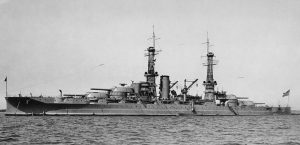 Most people know that the USS Arizona was one of the ships that was bombed when the Japanese attacked Pearl Harbor on December 7, 1941. The USS Arizona’s sinking took with it, 1,177 men…almost half of the total of 2,403 people killed at Pearl Harbor. The Arizona was one of 20 American ships and more than 300 airplanes lost that day. We know that the attack woke the sleeping giant that is the United States, and we joined World War II with the Allies to stop the tyranny that was Japan and later Germany and Italy. Most people know that the Allies were successful in World War II, and after four long years and the loss of over 400,000 lives, the war was over. There are a few facts about the USS Arizona that many people might not know, however.
Most people know that the USS Arizona was one of the ships that was bombed when the Japanese attacked Pearl Harbor on December 7, 1941. The USS Arizona’s sinking took with it, 1,177 men…almost half of the total of 2,403 people killed at Pearl Harbor. The Arizona was one of 20 American ships and more than 300 airplanes lost that day. We know that the attack woke the sleeping giant that is the United States, and we joined World War II with the Allies to stop the tyranny that was Japan and later Germany and Italy. Most people know that the Allies were successful in World War II, and after four long years and the loss of over 400,000 lives, the war was over. There are a few facts about the USS Arizona that many people might not know, however.
Twenty three sets of brothers died aboard USS Arizona. In all there were 37 confirmed pairs or trios of brothers assigned to the ship. Of the 77 men in those sets, 62 were killed. Only one full set of brothers survived. Kenneth and Russell Warriner survived because Kenneth was away at flight school in San Diego, and Russell, while badly wounded, lived. Also on board were father and son, Thomas Free and his son William who served and were killed aboard the Arizona that day. While no regulation exists, US officials discouraged siblings serving on the same ship after the Pearl Harbor attack. In addition to these men who died, the USS Arizona’s entire band, all 21 members, known as US Navy Band Unit (NBU) 22, were lost in the attack. Most of its members were up on deck preparing to play music for the daily flag raising ceremony when the attack began. They instantly moved to man their battle positions beneath the ship’s gun turret. It was the only time in American history that an entire military band died in action. In the years following the attack, and following the decision to leave the dead in the USS Arizona, it was decided that a memorial should be placed there. That is a known fact, but what I didn’t know was that in March 1961, Elvis Presley, who had recently finished a two year stint in the US Army, performed a benefit concert at 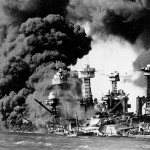
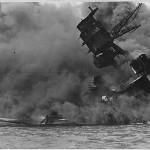 Pearl Harbor’s Block Arena that raised over $50,000. That was more than 10 percent of the USS Arizona Memorial’s final cost. The monument was officially dedicated on May 30, 1962.
Pearl Harbor’s Block Arena that raised over $50,000. That was more than 10 percent of the USS Arizona Memorial’s final cost. The monument was officially dedicated on May 30, 1962.
One of the most surprising facts about the Arizona, however, is related to the fuel. The day before the Pearl Harbor attack, the Arizona had taken on a full load of fuel…nearly 1.5 million gallons, because it was set to make a trip to the mainland later that month. When the Japanese bombers attacked, that fuel played a major part in the explosions and raging fire that followed the bombing. After the fires were put out, there were 500,000 gallons of fuel left in the ship. Now, 75 years later, the Arizona continues to spill up to 9 quarts of oil into the harbor each day. In the mid-1990s, concerns for the environment led the National Park Service to commission a series of site studies to determine the long term effects of the oil leakage. Some scientists have warned of a possible “catastrophic” eruption of oil from the wreckage, which they believe would cause extensive damage to the Hawaiian shoreline and disrupt US naval functions in the area. They continue to monitor the deterioration of the wreck site but are reluctant to perform extensive repairs or modifications due to the Arizona’s role as a “war grave.” In fact, the oil that often coats the surface of the water surrounding the ship has added an emotional gravity for many who visit the memorial and is sometimes referred to as the “tears of the Arizona” or “black tears.”
As surprising as that is, there is still one more fact that many people didn’t know. The bonds between the crewmembers of Arizona have lasted far beyond the loss of the ship on December 7, 1941. Since 1982, the US Navy has allowed survivors of USS Arizona to be interred in the ship’s wreckage upon their deaths. After a full military funeral at the Arizona memorial, the cremated remains are placed in an urn and then deposited by divers beneath one of the Arizona’s gun turrets. More than 30 Arizona crewmen who survived Pearl Harbor 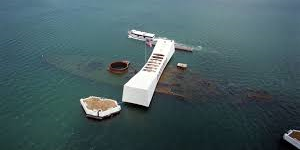 have chosen the ship as their final resting place. Crewmembers who served on the ship prior to the attack may have their ashes scattered above the wreck site, and those who served on other vessels stationed at Pearl Harbor on December 7, 1941, may have their ashes scattered above their former ships. As of November 2011, only 18 of the 355 crewmen who survived the bombing of USS Arizona are known to be alive. I knew that the Pearl Harbor attack had a deep impact on the lives of the survivors, but I guess I didn’t fully understand that it was a life changing event, and it would never really leave them.
have chosen the ship as their final resting place. Crewmembers who served on the ship prior to the attack may have their ashes scattered above the wreck site, and those who served on other vessels stationed at Pearl Harbor on December 7, 1941, may have their ashes scattered above their former ships. As of November 2011, only 18 of the 355 crewmen who survived the bombing of USS Arizona are known to be alive. I knew that the Pearl Harbor attack had a deep impact on the lives of the survivors, but I guess I didn’t fully understand that it was a life changing event, and it would never really leave them.
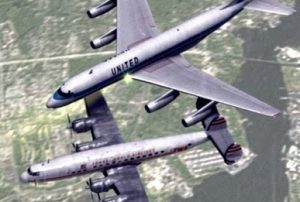
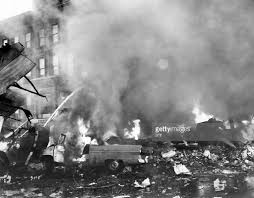 With the thousands of airplanes in the air at any moment, one might think that daily accidents would be common place, but in reality, air travel is actually very safe. Nevertheless, it is not without its tragedies. What tends to amaze me, however, is the fact that relatively few ever seem to crash in a city, even though the airports are usually very near cities. Still, there is not a perfect record of missing the cities, when it comes to plane crashes either, and when a plane crashes in a city, you know that the death toll will be higher, and more than likely will include people on the ground, who were just going about their day, completely unaware of the danger they were in.
With the thousands of airplanes in the air at any moment, one might think that daily accidents would be common place, but in reality, air travel is actually very safe. Nevertheless, it is not without its tragedies. What tends to amaze me, however, is the fact that relatively few ever seem to crash in a city, even though the airports are usually very near cities. Still, there is not a perfect record of missing the cities, when it comes to plane crashes either, and when a plane crashes in a city, you know that the death toll will be higher, and more than likely will include people on the ground, who were just going about their day, completely unaware of the danger they were in.
Such was the case on this day, December 16, 1960, in New York City, when two commercial airliners, a United  DC-8 from Chicago, that was heading to Idlewild Airport…now renamed John F Kennedy International Airport, in southern Queens, and a TWA Super Constellation from Dayton, Ohio that was heading to LaGuardia Airport in northern Queens, collided over the city, killing 134 people in the planes and on the ground. This remains the only such accident to occur over a major US city to this day. It was snowing that morning, and the United flight had been put into a holding pattern. Unfortunately, the pilot miscalculated the location of the pattern, the plane came directly into the path of the TWA flight, who was on approach to LaGuardia Airport. There were 128 people onboard the two planes, and all of them, except eleven year old Stephen Baltz were killed on impact. The boy would die from his injuries the next day, but he was lucid enough to give a brief account of the accident, saying that, “It looked like a picture out of a fairy book. Then all of a sudden there was an explosion. The plane started to fall and people started to scream. I held on to my seat and then the plane crashed.”
DC-8 from Chicago, that was heading to Idlewild Airport…now renamed John F Kennedy International Airport, in southern Queens, and a TWA Super Constellation from Dayton, Ohio that was heading to LaGuardia Airport in northern Queens, collided over the city, killing 134 people in the planes and on the ground. This remains the only such accident to occur over a major US city to this day. It was snowing that morning, and the United flight had been put into a holding pattern. Unfortunately, the pilot miscalculated the location of the pattern, the plane came directly into the path of the TWA flight, who was on approach to LaGuardia Airport. There were 128 people onboard the two planes, and all of them, except eleven year old Stephen Baltz were killed on impact. The boy would die from his injuries the next day, but he was lucid enough to give a brief account of the accident, saying that, “It looked like a picture out of a fairy book. Then all of a sudden there was an explosion. The plane started to fall and people started to scream. I held on to my seat and then the plane crashed.”
The TWA plane crashed onto Miller Field, a military airfield on Staten Island. The United flight, which was missing its right engine and part of a wing, came down in the middle of the Park Slope neighborhood of Brooklyn, narrowly missing Saint Augustine’s Academy. It hit an apartment building and the Pillar of Fire Church. Dozens of other buildings caught fire in the resulting explosion. Mrs Robert Nevin, who was sitting in a 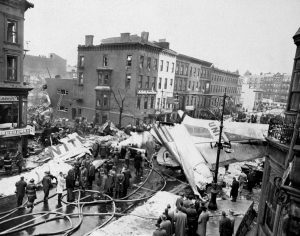
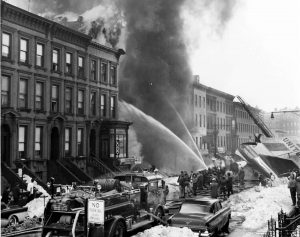 top floor apartment when the place crashed into her building, later said “The roof caved in and I saw the sky.” Six people on the ground died when the plane crashed, including the 90 year old caretaker of the church, Wallace Lewis, and two men who were selling Christmas trees nearby. Christmas presents carried by the plane’s passengers were strewn all over the streets. Firefighting efforts went on for nearly 72 hours because of the multiple fires.
top floor apartment when the place crashed into her building, later said “The roof caved in and I saw the sky.” Six people on the ground died when the plane crashed, including the 90 year old caretaker of the church, Wallace Lewis, and two men who were selling Christmas trees nearby. Christmas presents carried by the plane’s passengers were strewn all over the streets. Firefighting efforts went on for nearly 72 hours because of the multiple fires.
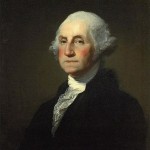
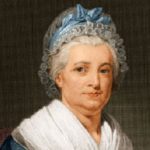 When we think of dinners with the President of the United States, we think of state dinners with tons of security, and massive pre-planning. Presidential dinners have changed distinctly since Washington’s day. The nation was much smaller for sure, and he could easily get together with all of his advisors and Congress in one place, I’m sure. In fact, George Washington was basically in uncharted waters. So, he decided that on Thursday evenings, he would have the brightest minds in the nation over for a casual dinner. At that time the nation’s capitol was still in New York City, so those casual dinners were never held in the White House. George Washington and his family lived in executive mansions in lower Manhattan, which was close to other governmental buildings in that era. While Washington entertained foreign dignitaries and other heads of state at public receptions on Tuesdays and Martha Washington regularly invited guests to their home on Fridays, Thursday evenings were reserved for formal dinners with congressional leaders, their wives and close personal friends of the Washingtons.
When we think of dinners with the President of the United States, we think of state dinners with tons of security, and massive pre-planning. Presidential dinners have changed distinctly since Washington’s day. The nation was much smaller for sure, and he could easily get together with all of his advisors and Congress in one place, I’m sure. In fact, George Washington was basically in uncharted waters. So, he decided that on Thursday evenings, he would have the brightest minds in the nation over for a casual dinner. At that time the nation’s capitol was still in New York City, so those casual dinners were never held in the White House. George Washington and his family lived in executive mansions in lower Manhattan, which was close to other governmental buildings in that era. While Washington entertained foreign dignitaries and other heads of state at public receptions on Tuesdays and Martha Washington regularly invited guests to their home on Fridays, Thursday evenings were reserved for formal dinners with congressional leaders, their wives and close personal friends of the Washingtons.
In reality, these dinners were elaborate affairs. They started promptly at 4:00pm, because Washington refused to wait for latecomers. I guess every president has his own idiosyncrasies. The parties numbered up to two dozen people, gathered around a table set with the Washington family silver and china. Unlike some state dinners, in which the President and his wife occupy the head of the table, Martha Washington preferred to sit in the middle of one side of the long table and President Washington sat directly across from her. The ends of the table were occupied by a secretary to help with the conversation and roast carving. The roast carving was necessary too, because there were a lot of roasts to be carved. The dinners were comprised of three courses, but that did no limit the selection. There would commonly be upwards of twenty different dishes in each course…all of which were brought to the table at the same time.
The various dishes were the finest that New York had to offer, and the guests were lavished with the exquisite meals. Manhattan was in the middle of New York City, but in 1700, it was still quite wild. The island had an assortment of venison, rabbit, and duck that were hunted for food. Oysters were abundant in the Hudson River. Jellies, dried fruits and nuts were served alongside, although you wouldn’t have seen potato or tomato dishes, because those foods were regarded as unfit for humans to eat in those days. Wine was drunk with dinner, although George Washington was said to prefer a tankard of ale over a glass of claret.
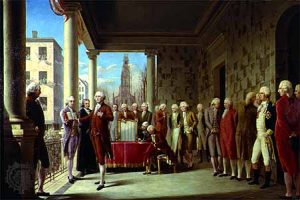
When dinner was over, Washington would raise a toast to the assembly, and then the ladies would retire to Martha’s drawing room for “coffee and civilized conversation.” The gentlemen would remain in the dining room, lingering over cigars and wine, but not for very long. The president only stayed another thirty minutes before joining the women in the drawing room. One of his personal secretaries would stay on in the dining room with the men to preside over political chats for another hour or so, until the company left and the Washingtons’ Thursday dinner was over…until the next week. George Washington passed away on this day, December 14, 1799.
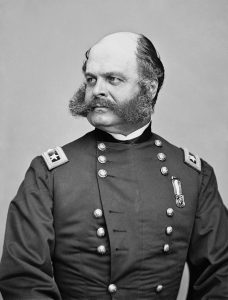 Those who have studied the Civil War, or know much about the United States at all, know that the Civil War was won by the Union, but that does not mean that there weren’t battles that they lost. There are very few wars that are lopsided in their battle field victories. One such battle was the Battle of Fredericksburg. On December 11, 1862, Ambrose Burnside, newly placed in command of the Army of the Potomac, planned to cross the Rappahannock River in Virginia with over 120,000 troops. When he finally crossed it, two days later, on December 13, 1862, he confronted 80,000 troops of Robert E Lee’s Confederate Army at Fredericksburg. With 200,000 combatants, this was the largest concentration of troops of any Civil War Battle. It was also one of the battles the Union Army would lose. In a crushing defeat, the Union Army suffered nearly 13,000 casualties, while the Confederate Army only lost 5,000.
Those who have studied the Civil War, or know much about the United States at all, know that the Civil War was won by the Union, but that does not mean that there weren’t battles that they lost. There are very few wars that are lopsided in their battle field victories. One such battle was the Battle of Fredericksburg. On December 11, 1862, Ambrose Burnside, newly placed in command of the Army of the Potomac, planned to cross the Rappahannock River in Virginia with over 120,000 troops. When he finally crossed it, two days later, on December 13, 1862, he confronted 80,000 troops of Robert E Lee’s Confederate Army at Fredericksburg. With 200,000 combatants, this was the largest concentration of troops of any Civil War Battle. It was also one of the battles the Union Army would lose. In a crushing defeat, the Union Army suffered nearly 13,000 casualties, while the Confederate Army only lost 5,000.
People might think that Burnside was not much of a commander, but it should be mentioned that this was the first time he had commanded an army. He was a graduate of West Point, had risen quickly up the ranks, and had seen action in several battles prior to this fateful day. Abraham Lincoln had approached him about taking control of the Union’s Army. He hesitated, partly out of loyalty to the current commander and former classmate, and partly because he was unsure of his own ability. In the end the prior commander’s failure assured that he was on the way out, and rather than have Major General Joseph Hooker, a fierce rival, pass him up, Burnside accepted the commission on November 7, 1862.
Knowing that he had to have the element of surprise, Burnside came up with a plan to confront Lee’s Army of Northern Virginia at Fredericksburg. He planned to move his forces to the banks of the neighboring Rappahannock River, and then transport his men across by way of hastily assembled pontoon bridges, and surprise the enemy. Lincoln was impressed with the audacity of the plan and approved it, but expressed doubts about its potential for success. Burnside swung into action, reaching the banks of the Rappahannock by November 19, 1862. We will never know if the plan might have succeeded, if some Union generals, including Winfield Scott Hancock, who believed the river could be crossed without the boats, had sent the boats…but instead, they urged Burnside to act without them. Burnside, who believed the river was too swift and deep, refused. They waited a week for the boats…unfortunately, under the watchful eyes of the Confederate scouts.
The element of surprise was gone. When they finally began building the pontoon bridges, the Confederate Army opened fire. Burnside began a massive bombardment of Fredericksburg, in the first shelling of a city in the Civil War. They were able to hold back the Confederate Army long enough to finish the bridges, and then they rushed across the river. Two days later, Burnside ordered his left flank to attack Lee’s right, in the hopes that Lee would have to divert forces to the south of the city, leaving the center and Marye’s Heights vulnerable. For a few hours, it looked like this might actually work. General George Meade broke through “Stonewell” Jackson’s line, but the Union failed to send in enough reinforcements to prevent a successful Confederate counterattack. Lee was able to keep James Longstreet’s men in position at Marye’s Heights, where they decimated Union forces. Burnside lost eight men for every Confederate soldier lost there. Though Burnside briefly considered another assault, the battle was over. The Union had suffered nearly 13,000 casualties while the Confederates lost fewer than 5,000. They needed to regroup before attacking again.
Burnside was an unpopular commander, partly I’m sure, because he felt the need to rush into things without really planning them out. His feelings of inadequacy proved to be his downfall. As he was planning his next attack, some of his leaders went to President Lincoln to voice their concerns. In the end, Lincoln halted the attack. On January 20, 1983, Burnside was ready to go again, but again the pontoon bridges were delayed. The weather didn’t help things either. What had been a dry January turned rainy, and the roads were all but impassible. Troops that had covered 40 miles a day on their way to Fredericksburg now struggled to get further than a mile. For three days, Burnside’s troops continued their disastrous slog on what would become known as the “Mud March,” accompanied most of the way by jeering Confederate forces taunting them from dry land. Five days after his offensive began, it was over…and so was Burnside’s brief, six week stint as commander of the Army of the Potomac. Lincoln immediately removed him from command, replacing him with the very person he feared it would be…Joseph Hooker.
Fredericksburg was the low point in the war for the North, but the South was ecstatic. Burnside probably should have stuck to his side career…weaponry design. And that was what he went back to. He retired in 1853 and in 1856 received his first patent for a .54 caliber breech loading firearm. Impressed with the carbine’s performance, the U.S. Army awarded the Bristol Firearm Company in Rhode Island…where Burnside worked…with a $100,000 contract. The order was soon rescinded, however, under shady circumstances. It’s believed that a rival munitions company bribed the army ordinance department to switch suppliers. Burnside’s bad luck continued the next year when a failed bid for a Congressional seat, followed closely by a fire that destroyed the Bristol factory, forced the financially strapped Burnside to sell his patents. Others would reap the rewards 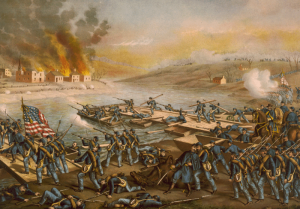 when, at the start of the Civil War, demand for his creation soared. By 1865, more than 55,000 carbines had been ordered, and the Burnside had become one of the most popular Union weapons of the war, second only to the Sharp carbine and my ancestor, Christopher Spencer’s Spencer carbine.
when, at the start of the Civil War, demand for his creation soared. By 1865, more than 55,000 carbines had been ordered, and the Burnside had become one of the most popular Union weapons of the war, second only to the Sharp carbine and my ancestor, Christopher Spencer’s Spencer carbine.
Burnside would eventually have a claim to fame, but it would not be for war or weapons. Burnside liked to wear his facial hair in what was an unusual way for the times. He had a bushy beard and moustache along with a clean-shaven chin. These distinctive whiskers were originally dubbed “burnsides,” but later the term would be altered and would become “sideburns.”
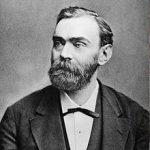 When Alfred Bernhard Nobel, the Swedish inventor of dynamite and other high explosives, died on December 10, 1896, he left a request in his will, that the bulk of his vast fortune be placed in a fund to finance an award to be “annually distributed in the form of prizes to those who, during the preceding year, shall have conferred the greatest benefit on mankind.” He did not state why he wanted to make such a bequest, but it was believed that he did so out of moral regret over the increasingly lethal uses of his inventions in war. The first Nobel Prizes are awarded in Stockholm, Sweden, in the fields of physics, chemistry, medicine, literature, and peace. The ceremony came on the fifth anniversary of Nobel’s death.
When Alfred Bernhard Nobel, the Swedish inventor of dynamite and other high explosives, died on December 10, 1896, he left a request in his will, that the bulk of his vast fortune be placed in a fund to finance an award to be “annually distributed in the form of prizes to those who, during the preceding year, shall have conferred the greatest benefit on mankind.” He did not state why he wanted to make such a bequest, but it was believed that he did so out of moral regret over the increasingly lethal uses of his inventions in war. The first Nobel Prizes are awarded in Stockholm, Sweden, in the fields of physics, chemistry, medicine, literature, and peace. The ceremony came on the fifth anniversary of Nobel’s death.
Educated in private schools in Saint Petersburg, Russia, Nobel excelled in Swedish, Russian, French, English and German. His primary interests were in English literature and poetry as well as in chemistry and physics. His interest in literature and poetry, was upsetting to his father, who considered him an introvert. He wanted his sons to become engineers, and to join his enterprise. In an effort to redirect Alfred’s interests, his father sent him abroad for further training in chemical engineering. During a two year period Alfred Nobel visited Sweden, Germany, France and the United States. In Paris, the city he came to like best, he worked in the private laboratory of Professor T J Pelouze, a famous chemist. There he met the young Italian chemist Ascanio Sobrero who, three years earlier, had invented nitroglycerine, a highly explosive liquid. Alfred Nobel proved himself to be a brilliant chemist. When his father’s business faltered after the end of the Crimean War, Nobel returned to Sweden and set up a laboratory to experiment with explosives. In 1863, he invented a way to control the detonation of nitroglycerin, which was previously regarded as too dangerous for use. Two years later, Nobel invented the blasting cap, an improved detonator that brought about the modern use of high explosives. Previously, the most dependable explosive was black powder, a form of gunpowder. Nitroglycerin remained dangerous, however, and in 1864 Nobel’s nitroglycerin factory blew up, killing his younger brother and several other people. Searching for a safer explosive, Nobel discovered in 1867 that the combination of nitroglycerin and a porous substance called Kieselguhr produced a highly explosive mixture that was much safer to handle and use. Nobel called his invention “dynamite,” for the Greek word dynamis, meaning “power.” Securing patents on dynamite, Nobel acquired a fortune as humanity put his invention to use in construction and warfare. Over his lifetime Alfred Nobel earned 355 patents.
All his work, left little time for a social life. At 43 years of age, feeling lonely and old, he placed an add for a woman who might become a suitable mate for him. The only one who came close to being the one, was Countess Bertha Kinsky, unfortunately she returned home and married Count Arthur von Suttner, but she and Nobel remained friends and kept writing letters to each other for decades. Over the years Bertha von Suttner became increasingly critical of the arms race. She wrote a famous book, Lay Down Your Arms and became a prominent figure in the peace movement. No doubt this influenced Alfred Nobel when he wrote his final will which was to include a Prize for persons or organizations who promoted peace. Several years after the death of Alfred Nobel, the Norwegian Parliament decided to award the 1905 Nobel Peace Prize to Bertha von Suttner.
The first Nobel Prizes were awarded on December 10, 1901, and subsequent prizes are awarded each year on 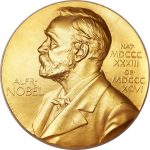 December 10, because it is the anniversary of Alfred Nobel’s death. It is the perfect day for the awards to be given. The Royal Swedish Academy of Sciences decides the prizes in physics, chemistry, and economic science. The Swedish Royal Caroline Medico-Surgical Institute determines the physiology or medicine award. The Swedish Academy chooses literature, and a committee elected by the Norwegian parliament awards the peace prize. In 2006, each Nobel Prize carried a cash prize of nearly $1,400,000 and recipients also received a gold medal, as is the tradition. Some notable winners have included Marie Curie, Theodore Roosevelt, Albert Einstein, George Bernard Shaw, Winston Churchill, Ernest Hemingway, Martin Luther King Jr, the Dalai Lama, Mikhail Gorbachev, and Nelson Mandela. All made Nobel efforts in their field.
December 10, because it is the anniversary of Alfred Nobel’s death. It is the perfect day for the awards to be given. The Royal Swedish Academy of Sciences decides the prizes in physics, chemistry, and economic science. The Swedish Royal Caroline Medico-Surgical Institute determines the physiology or medicine award. The Swedish Academy chooses literature, and a committee elected by the Norwegian parliament awards the peace prize. In 2006, each Nobel Prize carried a cash prize of nearly $1,400,000 and recipients also received a gold medal, as is the tradition. Some notable winners have included Marie Curie, Theodore Roosevelt, Albert Einstein, George Bernard Shaw, Winston Churchill, Ernest Hemingway, Martin Luther King Jr, the Dalai Lama, Mikhail Gorbachev, and Nelson Mandela. All made Nobel efforts in their field.
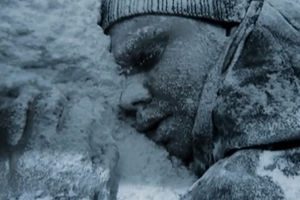 Sometimes, there are events in history that end up tied to other events in history, in one way or another. On this day, December 9, 2003, Tehran, Iran was hit by unseasonably cold temperature, that led to the deaths of 40 people from hypothermia. It is very rare to see such large groups of people die in this way at the same time, but it does happen, as seen in Tehran. Their deaths occurred when their core body temperature fell to 77 degrees Fahrenheit. So, how does this have anything to do with history beyond 2003? Well, it actually does, and not in a good way.
Sometimes, there are events in history that end up tied to other events in history, in one way or another. On this day, December 9, 2003, Tehran, Iran was hit by unseasonably cold temperature, that led to the deaths of 40 people from hypothermia. It is very rare to see such large groups of people die in this way at the same time, but it does happen, as seen in Tehran. Their deaths occurred when their core body temperature fell to 77 degrees Fahrenheit. So, how does this have anything to do with history beyond 2003? Well, it actually does, and not in a good way.
Most of us, these days, know about hypothermia. In fact, the causes and the fixes are pretty well known, but what I didn’t know before, although maybe I should have, is that the information we have on hypothermia came from the horrible experiments that the Nazis performed on the prisoners at the Dachau concentration camp during World War II. These unethical medical experiments that were carried out during the Third Reich fell into three categories. The first category consists of experiments aimed at facilitating the survival of Axis military personnel. In Dachau, physicians from the German air force and from the German Experimental Institution for Aviation conducted high-altitude experiments, using a low-pressure chamber, to determine the maximum altitude from which crews of damaged aircraft could parachute to safety. Scientists there carried out so-called freezing experiments using prisoners to find an effective treatment for hypothermia. While the findings might have been a good thing, the way the experiments were carried out was horrendous. After these experiments, most people knew that if they were 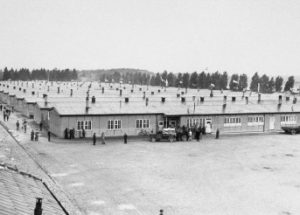 outside in frigid temperatures, they could die of hypothermia. Nevertheless, there were a few miracle situations, such as the two year old girl in Canada in 1994, who survived after her core body temperature dropped to 57 degrees Fahrenheit when she wandered away from her home in Saskatchewan.
outside in frigid temperatures, they could die of hypothermia. Nevertheless, there were a few miracle situations, such as the two year old girl in Canada in 1994, who survived after her core body temperature dropped to 57 degrees Fahrenheit when she wandered away from her home in Saskatchewan.
The second category of experimentation involved developing and testing pharmaceuticals and treatment methods for injuries and illnesses which German military and occupation personnel encountered in the field. Apparently the Nazis felt free to find ways to save their soldiers lives, at the expense of their prisoners. At the German concentration camps of Sachsenhausen, Dachau, Natzweiler, Buchenwald, and Neuengamme, prisoners were subjected to immunization compounds for the prevention and treatment of contagious diseases, including malaria, typhus, tuberculosis, typhoid fever, yellow fever, and infectious hepatitis. The Ravensbrueck camp was the site of bone-grafting experiments and experiments to test the efficacy of newly developed sulfanilamide drugs. At Natzweiler and Sachsenhausen, scientists tested prisoners with phosgene and mustard gas in order to find possible antidotes. Their lives simply didn’t matter when it came to the experimentation.
The third category of medical experimentation sought to advance the racial and ideological principles of the Nazi worldview. The most infamous were the experiments of Josef Mengele at Auschwitz. Mengele conducted medical experiments on twins. He also directed serological experiments on Roma Gypsies, as did Werner 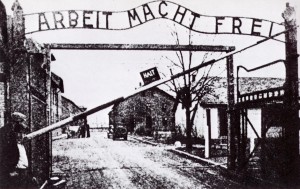 Fischer at Sachsenhausen, in order to determine how different “races” withstood various contagious diseases. The research of August Hirt at Strasbourg University also intended to establish “Jewish racial inferiority.” Other gruesome experiments meant to further Nazi racial goals were a series of sterilization experiments, undertaken primarily at Auschwitz and Ravensbrueck. There, scientists tested a number of methods in their effort to develop an efficient and inexpensive procedure for the mass sterilization of Jews, Roma Gypsies, and other groups that the Nazi leaders considered to be racially or genetically undesirable. It is difficult for me to even think about the cruelty that the Nazis inflicted on the Jews and Gypsies during those horrible years.
Fischer at Sachsenhausen, in order to determine how different “races” withstood various contagious diseases. The research of August Hirt at Strasbourg University also intended to establish “Jewish racial inferiority.” Other gruesome experiments meant to further Nazi racial goals were a series of sterilization experiments, undertaken primarily at Auschwitz and Ravensbrueck. There, scientists tested a number of methods in their effort to develop an efficient and inexpensive procedure for the mass sterilization of Jews, Roma Gypsies, and other groups that the Nazi leaders considered to be racially or genetically undesirable. It is difficult for me to even think about the cruelty that the Nazis inflicted on the Jews and Gypsies during those horrible years.
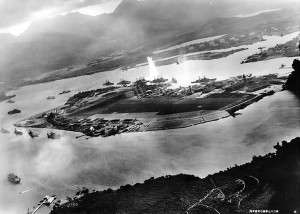
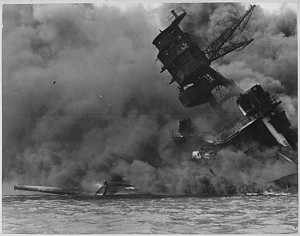 Whether people remember the date or not, I think that most people know that the attack on Pearl Harbor was what took the United States into World War II. Negotiations with Japan had broken down, and President Franklin Roosevelt and his advisors knew that in all probability, the Japanese would attack the United States. Still, nothing was done to increase security at key points, like the naval base at Pearl Harbor, Hawaii. This was especially an important base, because of it’s location. It was a place that early warning could have been given to the mainland, or where an attack could have been thwarted, but as often happens in government, the leaders don’t want to scare the nation, so they try to keep things from them…a plan the is fraught with folly. The best weapon a nation can possibly have is preparedness.
Whether people remember the date or not, I think that most people know that the attack on Pearl Harbor was what took the United States into World War II. Negotiations with Japan had broken down, and President Franklin Roosevelt and his advisors knew that in all probability, the Japanese would attack the United States. Still, nothing was done to increase security at key points, like the naval base at Pearl Harbor, Hawaii. This was especially an important base, because of it’s location. It was a place that early warning could have been given to the mainland, or where an attack could have been thwarted, but as often happens in government, the leaders don’t want to scare the nation, so they try to keep things from them…a plan the is fraught with folly. The best weapon a nation can possibly have is preparedness.
December 7, 1941 was a beautiful Sunday in Hawaii, 75 years ago today, and many military personnel had been given passes to attend church services off base. At 7:02am, two radar operators spotted large groups of aircraft in flight toward the island from the north, but with a flight of B-17s expected from the United States at the time, they were told not to sound an alarm. At 7:55am Hawaii time, a Japanese dive bomber bearing the red symbol of the Rising Sun of Japan on its wings appeared out of the clouds above the island of Oahu. Behind it came a swarm of 360 Japanese warplanes, descending on the US naval base at Pearl Harbor in a ferocious attack. The United States was unprepared, and the surprise attack struck a critical blow against the US Pacific fleet drawing the United States irrevocably into World War II.
In an attack that lasted just under two hours, the Japanese rendered much of the Pacific fleet useless, including five of eight battleships, three destroyers, and seven other ships that were sunk or severely damaged, and more than 200 aircraft that were destroyed. A total of 2,400 Americans were killed and 1,200 were wounded, many while scrambling in a valiant attempt to repulse the attack. Japan’s losses were some 30 planes, five midget submarines, and fewer than 100 men. Fortunately for the United States, all three Pacific fleet carriers were out at sea on training maneuvers. These giant aircraft carriers would exact their revenge against Japan six months later at the Battle of Midway, reversing the tide against the previously invincible Japanese navy in a spectacular victory…a beating that Japan would not forget.
The day after Pearl Harbor was bombed, President Roosevelt appeared before a joint session of Congress and declared, “Yesterday, December 7, 1941…a date which will live in infamy…the United States of America was suddenly and deliberately attacked by naval and air forces of the Empire of Japan.” After a brief and forceful speech, he asked Congress to approve a resolution recognizing the state of war between the United States and Japan. The Senate voted for war against Japan by 82 to 0, and the House of Representatives approved the resolution by a vote of 388 to 1. The sole dissenter was Representative Jeannette Rankin of Montana, a devout pacifist, who had also cast a dissenting vote against the United States entrance into World War I. Three days later, Germany and Italy declared war against the United States, and the United States government responded in kind. The American contribution to the successful Allied war effort spanned four long years and cost more than 400,000 American lives.
I have never personally been to Pearl Harbor, but I am told that the Arizona Memorial, that stands above the sunken ship, that is grave to the brave men who died inside, displays a feeling of sadness, and of being on 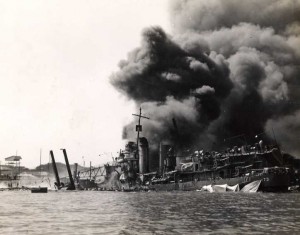
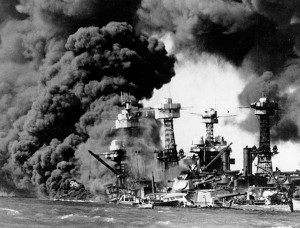 hallowed ground. It is a feeling I felt when I walked through the cemetery at Gettysburg. The men who died there…who bravely gave the ultimate sacrifice deserve the respect of those who would come to visit. I do not believe in ghosts, but I do believe that God gives cemeteries, in general, and military cemeteries especially an air of quiet honor reserved for the dead. Let us never forget that our greatest weapon in all areas of life is preparedness.
hallowed ground. It is a feeling I felt when I walked through the cemetery at Gettysburg. The men who died there…who bravely gave the ultimate sacrifice deserve the respect of those who would come to visit. I do not believe in ghosts, but I do believe that God gives cemeteries, in general, and military cemeteries especially an air of quiet honor reserved for the dead. Let us never forget that our greatest weapon in all areas of life is preparedness.
 I think that anyone who has seen pictures of Washington DC, knows about the monuments that are there. One of those monuments, dedicated to our first president is quite unique in its design…the Washington Monument. The Washington monument was completed on December 6, 1884 when the capstone was set in place, but was not dedicated until February 21, 1885 and didn’t officially open until October 9, 1888. In the six months following the dedication ceremony, over 10,000 people climbed the nearly 900 steps to the top of the Washington Monument. Today, an elevator makes the trip far easier, and more than 800,000 people visit the monument each year. Upon its completion, it became the world’s tallest building…at that time anyway…standing 554 feet 7 11/32 inches, and is made of some 36,000 blocks of marble and granite. A city law passed in 1910 restricted the height of new buildings to ensure that the monument will remain the tallest structure in Washington, DC…a fitting tribute to the man known as the “Father of His Country.”
I think that anyone who has seen pictures of Washington DC, knows about the monuments that are there. One of those monuments, dedicated to our first president is quite unique in its design…the Washington Monument. The Washington monument was completed on December 6, 1884 when the capstone was set in place, but was not dedicated until February 21, 1885 and didn’t officially open until October 9, 1888. In the six months following the dedication ceremony, over 10,000 people climbed the nearly 900 steps to the top of the Washington Monument. Today, an elevator makes the trip far easier, and more than 800,000 people visit the monument each year. Upon its completion, it became the world’s tallest building…at that time anyway…standing 554 feet 7 11/32 inches, and is made of some 36,000 blocks of marble and granite. A city law passed in 1910 restricted the height of new buildings to ensure that the monument will remain the tallest structure in Washington, DC…a fitting tribute to the man known as the “Father of His Country.”
The Washington Monument is an obelisk on the National Mall. First conceived in 1832, the Washington Monument took decades to build. By law, it is the tallest structure in the District of Columbia, and is twice as tall as any other obelisk in the world. Among memorials in Washington, it is unique. Whereas people visit 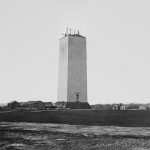 memorials to Lincoln and Jefferson to see giant statues of the men they commemorate, the highlight of the Washington Monument, is the monument itself. The smaller statue of Washington that sits inside the monument almost goes unnoticed. As John Steele Gordon wrote in his book, Washington’s Monument and the Fascinating History of the Obelisk, “The obelisk, silent as only stone can be, nonetheless seems to say as nothing else can, ‘Here is something significant.’”
memorials to Lincoln and Jefferson to see giant statues of the men they commemorate, the highlight of the Washington Monument, is the monument itself. The smaller statue of Washington that sits inside the monument almost goes unnoticed. As John Steele Gordon wrote in his book, Washington’s Monument and the Fascinating History of the Obelisk, “The obelisk, silent as only stone can be, nonetheless seems to say as nothing else can, ‘Here is something significant.’”
The monument’s construction began in 1848, but was halted from 1854 to 1877 due to a lack of funds, a struggle for control over the Washington National Monument Society, and the intervention of the American Civil War. The stone structure was finally completed in 1884, but internal ironwork, the knoll, and other finishing touches were not completed until 1888. A difference in shading of the marble, visible approximately 150 feet or 27% of the way up, shows where construction was halted and later resumed with marble from a different source. The original design was by Robert Mills, but he did not include his proposed colonnade due to a lack of funds, proceeding only with a bare obelisk. Despite many proposals to embellish the obelisk, only its original 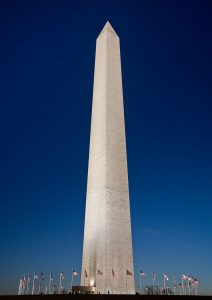 flat top was altered to a pointed marble pyramidion, in 1884.
flat top was altered to a pointed marble pyramidion, in 1884.
Anytime a structure is made of stone, you can expect that while it is very strong for the most part, things like tornadoes, earthquakes, and hurricanes can cause significant damage. Washington Monument was damaged during the 2011 Virginia earthquake and Hurricane Irene in the same year and had to be closed to the public while the structure was assessed and repaired. After 32 months of repairs, the National Park Service and the Trust for the National Mall reopened the Washington Monument to visitors on May 12, 2014. Then, as of September 2016, the monument had to be closed indefinitely due to reliability issues with the current elevator system. On December 2, 2016, the National Park Service announced that the monument would be closed until 2019 in order to modernize the elevator. The project is expected to run as much as $3 million to complete.
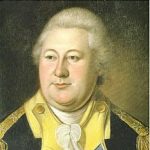 The Washington cousins, George and William, are cousins of my husband’s family as well, and so their heroism is of interest to me. General George Washington, before he became our first president, was a great general, who played a huge part in making the United States the great nation it is. But, there was another cousin, who played a part…whether George Washington knew that or not, I can’t say, but they did work together to bring a victory in the Revolutionary War that was quite unusual in it’s scope…for that era anyway. That cousin, was Henry Knox, who was born on July 25, 1750, the seventh of ten children of William and Mary Knox.
The Washington cousins, George and William, are cousins of my husband’s family as well, and so their heroism is of interest to me. General George Washington, before he became our first president, was a great general, who played a huge part in making the United States the great nation it is. But, there was another cousin, who played a part…whether George Washington knew that or not, I can’t say, but they did work together to bring a victory in the Revolutionary War that was quite unusual in it’s scope…for that era anyway. That cousin, was Henry Knox, who was born on July 25, 1750, the seventh of ten children of William and Mary Knox.
During the Revolutionary War, it was not unusual for armies to winter somewhere, and then pick up the war in the spring. Because they couldn’t go from place to place as quickly then as they do now, they were left with little choice. Soldiers could die in the frigid conditions, if they didn’t find someplace to wait out the winter months…or so it was thought. Knox was in the military serving with Massachusetts forces in the Army of Observation during the opening days of the Siege of Boston. His abilities soon brought him to the attention of new army commander General George Washington when the general inspected fortifications designed by Knox near Roxbury. The two men quickly became friends. When the army desperately needed artillery, Washington consulted Knox for advice in November 1775. Knox suggested the idea that the 59 cannons recently captured at the fall of forts Ticonderoga and Crown Point in upstate New York 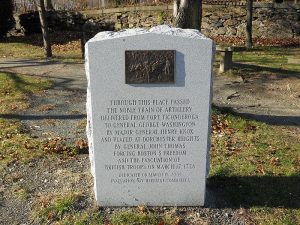 could have a decisive impact on the outcome of the siege. Knox did not have a commission in the army, but John Adams in particular worked in the Second Continental Congress to acquire for him a commission as colonel of the army’s artillery regiment. Washington was so impressed that he put Knox in charge of an expedition to retrieve them even though Knox’s commission had not yet arrived. Reaching Ticonderoga on December 5, 1775, Knox commenced what came to be known as the noble train of artillery, hauling by ox-drawn sled 60 tons of cannons and other armaments across some 300 miles of ice covered rivers and snow draped Berkshire Mountains to the Boston siege camps.
could have a decisive impact on the outcome of the siege. Knox did not have a commission in the army, but John Adams in particular worked in the Second Continental Congress to acquire for him a commission as colonel of the army’s artillery regiment. Washington was so impressed that he put Knox in charge of an expedition to retrieve them even though Knox’s commission had not yet arrived. Reaching Ticonderoga on December 5, 1775, Knox commenced what came to be known as the noble train of artillery, hauling by ox-drawn sled 60 tons of cannons and other armaments across some 300 miles of ice covered rivers and snow draped Berkshire Mountains to the Boston siege camps.
The region they were traveling through to reach Boston was lightly populated and Knox had to overcome difficulties with hiring personnel and obtaining animals. On several occasions cannons crashed through the ice on river crossings, but the detail’s men were always able to recover them. In the end, what Knox had expected to take just two weeks actually took more than six, but he was finally able to report the arrival of the weapons train to Washington on January 27, 1776. The operation was called “one of the most stupendous feats of logistics” of the entire war by historian Victor Brooks. Knox’s effort is commemorated by a series of plaques marking the Henry Knox Trail in New York and Massachusetts.

Upon their arrival in Cambridge the cannons were immediately deployed to fortify the Dorchester Heights recently taken by Washington. So commanding was the new battery over Boston harbor the British withdrew their fleet to Halifax. With the siege ended, Knox undertook the improvement of defenses in Connecticut, Rhode Island, and New York City in anticipation of British attack there. In New York he met Alexander Hamilton, commander of the local artillery. The two men formed a close friendship that lasted until Hamilton’s death in 1804. During his military service Knox also established a close friendship with fellow Massachusetts native Benjamin Lincoln. Henry Knox would go down in history as being one of the great strategists in this nation.

